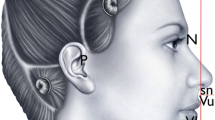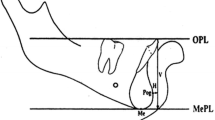Abstract
Background and Objectives
With increasing aesthetic awareness, in addition to the forehead, nose, and cheekbone prominence, the chin nowadays is seen as one of the most important parts of the facial skeleton. Position of the chin has a strong influence on the assessment of the facial harmony; its different types and forms dominate the appearance. Furthermore, the expression of the chin is equated with character traits, and thus, it is an important component of the profile forms. Genioplasty is a routine procedure for the correction of aesthetic and functional deformity of the chin region. It is therefore one of the contour-enhancing surgical methods. The purpose of the present study is to study the versatility of sagittal curving osteotomy for advancement genioplasty as an alternative to conventional technique.
Materials and Methods
A total of 24 subjects were enrolled for the study who were randomly distributed into two groups: group 1(n−12) comprising of patients in whom sagittal curving osteotomy was done and group 2 (n- 12) comprising of patients in whom conventional osteotomy was done. Neurosensory disturbances and hard and soft tissue relapse were compared between the two groups.
Results
On comparison of all the variables, it was found that the conventional osteotomy technique had more hard tissue relapse and more neurosensory disturbance as compared to sagittal curving osteotomy technique.
Conclusion
Results of this study suggest that the use of sagittal curving osteotomy may be helpful in reducing postoperative neurosensory disturbances and relapses following genioplasty. Hence, it is recommended that sagittal curving osteotomy can be used as an alternative osteotomy technique for advancement genioplasty.





















Similar content being viewed by others
References
Patnaik VVG, Rajan S, Sanju B (2003) Anatomy of ‘a beautiful face & smile.’ J Anat Soc India 52(1):74–80
Peck H, Peck S (1969) A concept of facial esthetics. Angle Orthod 40:284
Janson HW (1963) History of art. Harry N. Abrams Inc, New York, p 40
Arroyoa HH, Olivetti IP, Lima LF, Juradoc JRP (2016) Clinical evaluation for chin augmentation: literature review and algorithm proposal. Braz J Otorhinolaryngol 82:596–601
Guyuron B (1992) Genioplasty. Little, Brown, Boston
Aufrecht G (1934) Combined nasal plastic and chin plastik correction of microgenia by osteocartilaginous transplant from large hump nose. Am J Surg 22:292
Hofer O (1942) Die operative Behandlung der alveolärenRetraktion des Unterkiefers und ihreAnwendungsmöglichkeitfürPrognathie und Mikrogenie. Dtsch Zahn Mund Kieferheilk 9:121
Precious DS, Delaire J (1985) Correction of anterior mandibular vertical excess: the functional genioplasty. Oral Surg Oral Med Oral Pathol 59(3):229–235
Cadogan J, Bennun I (2011) Face value: an exploration of the psychological impact of orthognathic surgery. Br J Oral Maxillofac Surg 49(5):376–380
Segner D, Höltje WJ (1991) Long-term results after genioplasty [in German]. FortschrKieferorthop 52(5):282–288
Shaughnessy S, Mobarak KA, Høgevold HE, Espeland L (2006) Long-term skeletal and soft-tissue responses after advancement genioplasty. Am J Orthod Dentofacial Orthop 130(1):8–17
Lindquist C, George Obeid G (1988) Complications of genioplasty done alone or in combination with sagittal split-ramus osteotomy. Oral Surg Oral Med Oral Pathol 66:13–16
Defreitas CE, Ellis-iii E, Sinn DP (1992) A retrospective study of advancement genioplasty using a special bone plate. J Oral Maxillofac Surg 50:340–346
Strauss RA, Abubaker AO (2000) Genioplasty: a case for advancement osteotomy. J Oral Maxillofac Surg 58:783–787
Bell WH, Dann JJ (1973) Correction of dentofacial deformities by surgery in the anterior part of the jaws. Am J Orthodontist Dentofacial Orthopaedics 64(2):162–187
Busquets CJ, Sassouni V (1981) Changes in the integumental profile of the chin and lower lip after genioplasty. J Oral Surg 39(7):499–504
Gallagher DM, Bell WH, Storum KA (1984) Soft tissue changes associated with advancement genioplasty performed concomitantly with superior repositioning of the maxilla. J Oral Maxillofac Surg 42(4):238–242
Tulsane JF (1987) The overlapping bone flap genioplasty. J Craniomaxillofac Surg 15(4):214–221
Park HS, Ellis E 3rd, Fonseca RJ, Reynolds ST, Mayo KH (1989) A retrospective study of advancement genioplasty. Oral Surg Oral Med Oral Pathol 67(5):481–489
Krekmanov L, Kahnberg KE (1992) Soft tissue response to genioplasty procedures. Br J Oral Maxillofac Surg 30(2):87–91
Polido WD, Bell WH (1993) Long-term osseous and soft tissue changes after large chin advancements. J Craniomaxillofac Surg 21(2):54–59
Ousterhout DK (1996) Sliding genioplasty: avoidind mental nerve injury. J Craniofac Surg 74:211
Guyot L, Layoun W, Richard O, Cheynet F, Gola R (2002) alteration of chin sensibility due to damage of the cutaneous cranch of the mylohyoid nerve during genioplasty. J Oral Maxillofac Surg 60:1371–1373
Wolfe SA, Rivas-Torres MT, Marshall D (2006) The genioplasty and beyond: an end-game strategy for the multiply operated chin. Plast Reconstr Surg 60:1012–1017
Sarmento GS, Denadai R, Somensi RS, Giancolli AP, Junqueira JG, Neto et al (2013) Evaluation of neurosensory disturbance in patients with craniofacial syndrome subjected to horizontal chin advancement. Rev Bras Cir Plást 28(2):205–211
Talebzadeh N, Pogrel MA (2001) Long-term hard and soft tissue relapse rate after genioplasty. Oral Surg Oral Med Oral Pathol Oral RadiolEndod 91(2):153–156
Veltkamp T, Buschang PH, English JD, Bates J, Schow SR (2002) Predicting lower lip and chin response to mandibular advancement and genioplasty. Am J Orthod Dentofacial Orthop 122(6):627–634
Seo K, Tanaka Y, Terumitsu M et al (2005) Characterization of different paresthesias following orthognathic surgery of the mandible. J Oral Maxillofac Surg 63:298
Jaaskelainen SK, Peltola JK, Lehtinen R (1996) The mental nerve blink reflex in the diagnosis of lesions of the inferior alveolar nerve following orthognathic surgery of the mandible. Br J Oral Maxillofac Surg 34:87
Jaaskelainen SK, Teerijoki-Oksa T, Virtanen A et al (1951) Sensory regeneration following intraoperatively verified trigeminal nerve injury. Neurology 2004:62
Kobayashi A, Yoshimasu H, Kobayashi J et al (2006) Neurosensory alteration in the lower lip and chin area after orthognathic surgery: bilateral sagittal split osteotomy versus inverted L ramus osteotomy. J Oral Maxillofac Surg 64:778
Schultze-Mosgau S, Erbe M, Rudolph D et al (1999) Prospective study on post-traumatic and postoperative sensory disturbances of the inferior alveolar nerve and infraorbital nerve in mandibular and midfacial fractures. J Craniomaxillofac Surg 27:86
Schultze-Mosgau S, Krems H, Ott R et al (2001) A prospective electromyographic and computer-aided thermal sensitivity assessment of nerve lesions after sagittal split osteotomy and Le Fort I osteotomy. J Oral Maxillofac Surg 59:128
Author information
Authors and Affiliations
Corresponding author
Additional information
Publisher's Note
Springer Nature remains neutral with regard to jurisdictional claims in published maps and institutional affiliations.
Rights and permissions
About this article
Cite this article
Aich, S., Singarapu, R., Shetty, A. et al. Evaluation of Sagittal Curving Osteotomy vs Conventional Advancement Genioplasty in Retrogenia Patients: a Randomized Control Trial. J. Maxillofac. Oral Surg. 21, 1244–1258 (2022). https://doi.org/10.1007/s12663-021-01578-1
Received:
Accepted:
Published:
Issue Date:
DOI: https://doi.org/10.1007/s12663-021-01578-1




